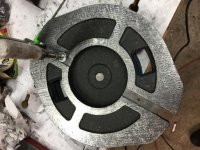I'm new to scraping, but have attempted to do my homework before asking this question.
When scraping, we are looking for a good pattern of points of contact at 20-14 PPI. for these to be contact points, they need to be slightly proud of the average surface, so that each point is a "peak". (understanding that the actual topography created by scraping is still very flat).
Where I get confused though, is in determining:
1. how large these spots should be? is larger or smaller better?
2. how much does/should stoning process affect the spot pattern?
3. is stoning really lapping the high spots? If so, doesn't the flatness of the stone become critical, or does stoning technique need to make up for this by rotating the stone in some way?
A frequent result of my inexpert scraping is that I end up with large patches of blued surface. Say, 1cm[SUP]2[/SUP], separated by large areas of no contact. I'm assuming that either my scraping marks are too close, or my scraper geometry is not good for the attack angle that I am using on the part. Or I am stoning too much between passes and removing small high spots.
When scraping, we are looking for a good pattern of points of contact at 20-14 PPI. for these to be contact points, they need to be slightly proud of the average surface, so that each point is a "peak". (understanding that the actual topography created by scraping is still very flat).
Where I get confused though, is in determining:
1. how large these spots should be? is larger or smaller better?
2. how much does/should stoning process affect the spot pattern?
3. is stoning really lapping the high spots? If so, doesn't the flatness of the stone become critical, or does stoning technique need to make up for this by rotating the stone in some way?
A frequent result of my inexpert scraping is that I end up with large patches of blued surface. Say, 1cm[SUP]2[/SUP], separated by large areas of no contact. I'm assuming that either my scraping marks are too close, or my scraper geometry is not good for the attack angle that I am using on the part. Or I am stoning too much between passes and removing small high spots.



